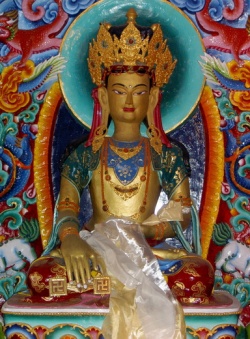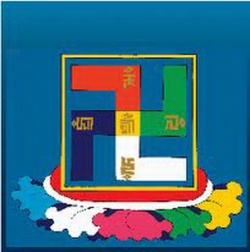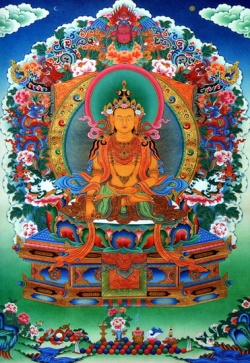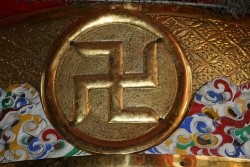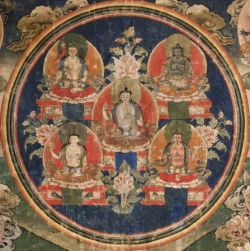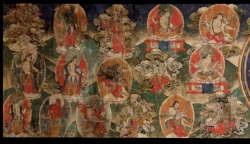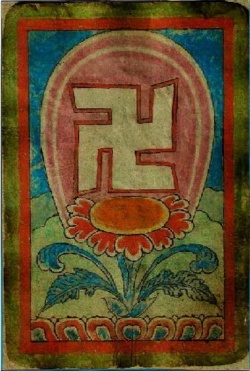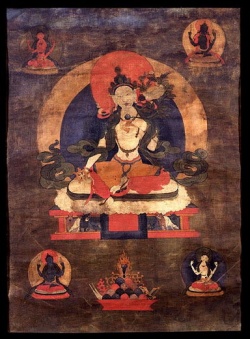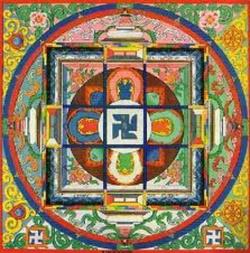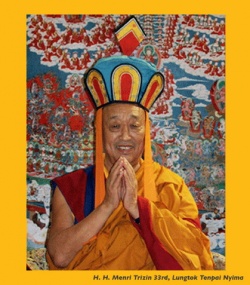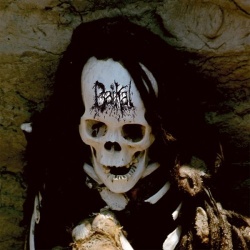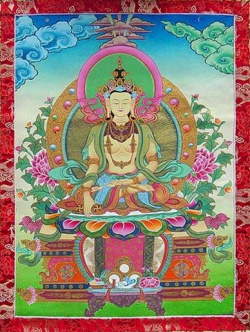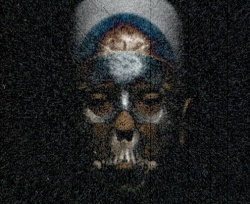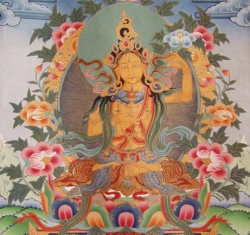The Mother Tantras
by Marco Alejandro Chaoul
The Mother Tantras "represent an important esoteric tradition of Bon belonging to the system of A dkar ba the way of the white A, the seventh in the stages of Nine Ways of Bon (theg pa rim dgu) Among the Bon Tantras, the Mother, and the Father Tantras (pha rgyud) comprise the highest classes . Their method of practice is transformation (bsgyur ba), and whereas in the Father Tantras the generation stage (bskyed rim) is emphasized (including intricate visualizations of deities and their mandala), in the Mother Tantras the completion stage (rdzogsrim) is stressed.
The Mother Tantra is attributed "within the root texts themselves to Kuntu Zangpo (Kun tu bzang po Samantabhadra, "Totally Good One"]), the Primordial Buddha Himself;" a characteristic that is shared with other Bon and Nyingma high tantra and dzogchen texts. And has the quite unique characteristic that the male aspect represents the emptiness quality and the female aspect the clarity of the Natural State, which is usually inverted in other tantric texts. Furthermore, "the Mother Tantra is also unique among the Higher Tantras as a whole because, whereas it does employ the transformational process of the Kyerim generation stage and the Dzogrim completion stage, its overall view is that of Dzogchen.” Dzogchen is the highest teaching in this tradition, and its method of practice is of self-liberation (rang grol) into the non-dual single essence (thig le nyaggtig).
According to the Bon tradition, the Root Texts of the Secret Mother Tantra are said to be originated in the dimension of Bon (ban sku), shared by the male and female Primordial Buddhas in the "Eternal Divine language" (gyung drung lha'i skad), then transmitted in Sanskrit to a retinue of skygoers amongst whom the principal was Zangza Ringtsun (bZang za ring btsun, "Good wife Long excellence"), an emanation of the great Cham Ma (Byams ma, "Loving Mother"). The Teachings of the Mother Tantra were revealed by her to three teachers who propagated the Mother Tantra in three different among the Nagas in the netherworld, and Milu Samlek (Mi lus bsant legs) among humanity on earth (114).
According to the Secret Mother Tantra texts, Milu Samlek then composed three commentaries in order to elucidate their meaning, and transmitted the teachings to his disciple Mushen Namkha Nangwa Dogchen (dMu gshen nam mkha' snang ba'i mdog can). The latter, after practicing on the slopes of Mount Kailash, bestowed the initiation and instructions to the Bon pandit Anu Tragtak (A nu 'phrag thag)f who in turn handed this teachings down to Sene Gau (Sad na ga'u) of Zhang Zhung. Sene Gau translated the teachings from Zhang zhung to Tibetan. It was during his time that the first persecution of Bon teachings and practitioners took place, under the reign of the Tibetan Buddhist king Drigum Tsenpo (Gri gum btsan po, ca. 683 B.C.E.), and therefore, "the custodianship of these texts of the ma rgyud was delivered by Sad ne ga'u into the hands of the six Dakinis of the Path, the Jarama (bya ra ma) or watchers,"115 "who served as the 'treasure protectors'."
Under king Trisong Detsen (Khri srong Ide btsan, 790-848 C.E.) the Bonpos suffered a second persecution, and it was not until the twelfth century that the Secret revelation of the Mother Tantras were rediscovered by Guru Nontse (Gu ru rnon rise) in the rock of Dungpor (Dung phor bkra shis) near the village of Tanag (rTa nag) in the central province of Tsang, "[h]ence this collection of Terma became known by the name of the Dung phor ma." Guru Nontse then gave this collection of teachings to Zhonu (gZhon nu). But the Secret Mother Tantra Cycle was not the only Mother Tantra Cycle.
Within the Bon tradition, there are three cycles of Mother Tantras: Outer, Inner, and Secret. For each, there is a root text or texts with a body of exegetical and liturgical works subordinate to the root text. " Milu Samlek wrote separate commentaries for each of the three cycles, but this study will focus on the Secret cycle (gsang skor). The Outer Cycle (phyi skor) and Inner Cycle (nang skor), named rNam dag padma klong gi dkyil 'khor and Kun gsal byams ma chen mo'i rgyud respectively, were discovered at different times by different people.
Herab th.jpg
[[File:|thumb|250px|]]
For example the Inner Mother Tantra texts were excavated earlier— Namkhai Norbu places it in 956 C.E.— by the Terton Trotsang Druglha (Khro tshang brug lha).(119) It is interesting to note that, [t]hree generations after their rediscovery, the laving Mother Inner Mother Tantra) texts were given to gZhon nu and were then passed along the same lineage with the Secret Mother Tantra literature .
Also Guru Nontse, who was the rediscoverer of the Secret Mother Tantra, "may be identified as an incarnation of one of the members of the earlier lineage."121
The lineage, as Martin says, is more than the mere passing down the oral tradition, but is also the "transference of the 'charisma' (byin brlabs) [or blessings) of the institutor of the lineage." 122 This acknowledges not only an intimate connection among the lineage-holders, but also opens a window into an understanding beyond the purely historical.123 Guru Nontse "was known in the Buddhist histories as Aya Bonpo Lhabun (A ya bon po lha 'bum), for he discovered many Nyingma Termas as well as Bonpo ones." 124 The Secret Mother Tantra text, like many of such discoveries, was discovered by "accident."125 Guru Nontse, who was a hunter and a potter,126 had hunted an antelope in the mountain, and was chopping its bones on a rock when suddenly the rock broke apart. To his amazement inside the rock he found a white silk cloth written on both sides and wrapped on a stick.
The story goes that Zhonu, who was from Kham (East Tibet), had a dream where the skygoers prophesied that he was to receive an important text. Some time later, he was in fact handed the Secret Mother Tantra silk cloth directly from Guru Nontse. He told Zhonu that he had already transcribed many texts, and "[s]ince you have transferred from a divine status, your thoughts are pure and you are very quiet and relaxed. So copy the texts without anyone seeing them."127 Then Zhonu went to Kham and copied the texts, but some time later Guru Nontse appeared unexpectedly and asked for the silk cloth, alleging that the skygoers wanted the cloth to be returned. Asking Zhonu, "Did you see the five loose open-mouthed tigresses pass by at Dung phor?,"128 Guru Nontse took the roll back.
Now, according to Martin, Zhonu had copied all the Secret Mother Tantra: the three root texts (of Base, Path, and Fruit), and the three commentaries of them by Milu Samlek (the short and medium commentaries where on one side of the roll and the detailed commentary on the other side); but then could not find the most detailed commentary. But according to Lopon and Reynolds (who was probably also informed by Lopon), Guru Nontse appeared before Zhonu could finish copying the whole roll, so that Zhonu never got to the side of the longer commentary nor had time to copy down the short commentary. Thus, Lopon states that Zhonu was only able to copy the medium length commentary.129
All versions coincide in that the silk roll which Guru Nontse gave to Zhonu contained the three Root Tantras together with the three sets of Commentaries: the Meaning Commentary: Solar Essence (don 'grel nyi ma 'i snying po), which is the abridged commentary;130 the Meditation Commentary: Mandala of the Sun (sgom 'grel nyi ma'i dkyil 'khor), which is the intermediate length commentary; and the Explanation Commentary: Solar Rays.(bshad 'grel nyi ma'i 'od zer), which is the extended commentary, containing word by word explanation of the three root texts of the Secret Mother Tantra. Martin agrees with Karmay in thinking that even when it is stated that Milu Samlek composed all three commentaries, it is not very dear which one we are dealing with. The commentary in hand [the [[Secret} Mother Tantra]]: Root Commentary of the Three Buddhahood Tantras (ma rgyud sangs rgyas rgyud gsum rtsa 'grel) states at the beginning (p. 207) that it is the Meditation Commentary: The Solar Essence, but on p. 208 it indicates that it is the Meditation Commentary: The Mandala of the Sun.131
As Martin points out "there is some confusion in the titling of the texts," since Solar Essence is suppose to be the abridged or Meaning Commentary, and not the Meditation Commentary.132 Lopon Tenzin Namdak, and John Reynolds following him, do not view this as a problem. The discrepancy might arise from what it is believed Zhonu was able to copy down before hearing that the "five Dakinis riding on tigers had just appeared uttering dire prophesies."133 According to Lopon, Zhonu was able to copy down the three root texts and only the intermediate length commentary. At that time, Guru Nontse asked Zhonu to give him the silk roll back no matter how much was copied, since he had to return it to where he found it. The silk cloth was never found again, consequently the Meditation Commentary: Mandala of the Sun is the only extant commentary.
Karmay and Martin's confusion may derive from the inclusion of the enumeration of the forty five wisdom spheres (ye shes thig le zhe /nga), which is pretty much all the abridged commentary — in the introduction of the extant text. There is no doubt that it is the Meditation Commentary; as seen in the above citation, whether it is called Solar Essence or Mandala of the Sun, it is Meditation Commentary in both cases. I can think of two possible answers to this dilemma, and propose them only as speculations. Limiting myself to the 1971 edition that Martin and Karmay were mainly working from, it is possible that giving the introduction the same name as the abridged commentary was a way of acknowledging that the medium length commentary included the abridged one.
But working from a later edition, not included in Karmay's catalogue since it is from 1985,134 that same chapter 4 (or nga in the 1971 edition)-the first three chapters being the Root Texts-is actually called Meditation Commentary: Mandala of the Sun], which would then seem to resolve the conflict.135 Martin acknowledges this and says that "[m]ost likely M [which is how he terms the 1971 edition] is mistaken, and the correct title of the set of commentaries available to us should be Solar Mandala or Mandala of the Sun."136 Where the biggest difference seems to lie is in what is comprised under the other part of the title, namely, Meditation Commentary. Martin seems to follow Karmay in considering it to include not only chapter nga, where the title is presented, but all the Commentary of the Tantra of the Base (chapters nga to no). While I see this as true, I only see it as partially so.
Karmay states that there is "no title" for the Commentary of the Path (chapters pa to 'a}, and so Martin seems to assent.137 I believe that in fact the same title extends all the way from chapters nga to 'a, and that the Meditation Commentary: Mandala of the Sun is the medium length Commentary of Base, Path, and Fruit (even though Milu Samlek's Commentary of the Fruit is no longer extant), and not just of the Base.138
Lopon also said that when Guru Nontse appeared to Zhonu in Kham, and the latter wanted to finish copying the material, Guru Nontse told him not only that the five tiger-like skygoers had come asked for it, but also that copying the long commentary was of no use because, in Tibet, there were no suitable students to receive this teaching. Guru Nontse said that Tibetan people had a deluded base, misunderstood the path and therefore the fruit would be spoiled.139 As far as Zhonu himself, Guru Nontse told him to practice what he had already copied and keep it for himself, since other people would not understand it properly. The original copy was then returned.140
The structure of the Secret Mother Tantra.
The three root texts of the Secret Mother Tantras (M) are collectively known by two different titles: 1. The Three Buddhahood Tantras (Songs rgyas rgyud gsum), and 2. Compassion Sun ; Sun of Compassion (Thugs rje nyi ma).160
Lopon Tenzin Namdak says there are not two different titles, rather, like most Tibetan texts, one is the title and the other the subtitle, or explanation of what the text contains. In other words, the Secret Cycle of the Mother Tantra is known as Mother Tantra: The Tantric Cycle of the Sun of Compassion (Ma rgyud thugs rje nyi ma'i rgyud skor), which is "The Three Root Buddhahood Tantras with Commentaries." 161 Interestingly enough, the 1985 edition uses the former name, while the 1971 edition uses the latter (Ma rgyud songs rgyas rgyud gsum rtsa 'grel).
In content both editions are the same, but here I will use the most recent one, which as seen earlier, may also prove to be more reliable. The Sun of Compassion is divided in two manners: as the Forty-five Wisdom Spheres which the introduction enumerates, and as the [[Three Buddhahood Tantras, of base, pat], and fruit]]. The cho practice is found in the Second Tantra (i.e., the Path), and is the twenty-second wisdom sphere: the Sphere of Accumulation, the Completion with Respect to the Accomplishment of Wisdom (Tshogs kyi thig le ye shes grub la rdzogs). An overview of the outline for all Three Tantras will be helpful in order to understand the structure of the Bon Secret Mother Tantra Cycle as a whole and the place of cho in it.162
The Bon Secret Mother Tantra is first divided into three parts: base (gzhi), path (lam), and fruit ('bras), which are subdivided into six parts each, altogether making eighteen steps that the practitioner should pursue in order to attain liberation. In the 1985 edition, the first three chapters are the three Root Tantras, and chapter four (nga), as was discussed earlier, is what Martin calls the historical preface. Then, the text is divided as follows:
I- The commentary of the six facets of the base:
1- "The Total-base of the spontaneously-manifested wisdom teachings" (Kun gzhi ye shes Ihun grub bstan pa), which is an explanation of the introduction to the natural state .(chapter 5).
2- "The Appearing-base of the spontaneously-manifested three enlightened dimensions" (Snang gzhi sku gsum Ihun grub), of truth dimension (ban sku, dharmakaya), perfected dimension (rdzogs sku, sambhogakaya), and manifested dimension (sprul sku, nirmanakaya)163 (ch. 6).
3- "The Empty-base of the spontaneously-manifested four enlightened dimensions" (Stong gzhi sku bzhi Ihun grub), where the four dimensions are explained in four different chapters in terms of channels (rtsa, nodi), vital breath (rlung, prana),[[essential] sphere (thig le, bindu), and performance (spyod pa, bhoga or carya), each explained in a different chapter (ch. 7 to 10 respectively).
4- "The Scriptural-base of the spontaneously-manifested four empowerments" (Lung gzhi dbang bzhi Ihun grub): external (phyi bo), internal (nang ba), secret (gsang ba), and esoterical or ultra-secret (yang gsang ba) (ch. 11).
5- The Meaning-base of the spontaneously-manifested view and conduct" (Don gzhi Ita spyod Ihun grub), where instructions for familiarizing oneself with methods for stabilization practice (zhi gnas) are given (ch. 12).
6- The Activity-base of the spontaneously-manifested deed (Las gzhi 'phrin las Ihun grub) (ch. 13).
Chapter 14 relates the history of the lineage.
II- The six parts of the path are:
1- The path of Accumulation (Tshogs lam,) (ch. 15).
2- The path of Union (sByor lam) (ch 16).
3- The path of Seeing (Thong lam) (ch. 17).
4- The path of Meditation (sCom lam) (ch. 18 to 22).
The path of meditation comprises six methods or "principles of expediency" (lam khyer drug), which are "only with some difficulty compared with the Six Dharmas of Naropa."164 The six principles of expediency are:
• The expedient use of Means, devoted mainly to the channels and vital breath, which corresponds to " the sphere of the Elements" (Byung ba'i thig le) (ch. 18).
• The expedient use of Dream (rmi lam) which corresponds to "the sphere of Self-ness" (bDag nyid thig le) (ch. 19).
• The expedient use of Fear, which is the practice of cho or practice of fearful places (gnyan sa lam), which corresponds to "the sphere of Accumulation" (Tshogs gyi thig le) (ch. 20).
• The expedient use of Projection ('pho ba) which corresponds to "the sphere of Accomplishing" (Grub pa'i thig le]]) (ch. 21).
• The expedient use of Death which explains the after-death intermediate states (bar do) and corresponds to "the sphere of Abiding" (gNas gyi thig le). Its commentary has been missing since its re-discovery by Guru Nontse.
• The expedient use of Sleep (gnyid pa lam khyer) which corresponds to "the sphere of Clarity" (gSal ba'i thig le) (ch. 22).
Some of the six methods correspond to the ones of Naropa and others do not, cho is not part of the [[six dharmas of Naropa.165
5- The path of Freedom (Thar lam,) (ch 23).
6-The path of Ripening and Liberation (sMin grol lam) (ch 24 and 25).
This six parts of the path of meditation are also the second to the seventh grounds (sa, bhumi) of the path of a bodhisattva, where the path of seeing is the first, the path of freedom the eight, the path of ripening the ninth, and the path of liberation the tenth.
HI- The six parts of the fruit166 are:
1- The fruit of Excellence (mChog 'bras).
2- The fruit of Meaning (Don 'bras).
3- The fruit of Practice Session (Thun 'bras).
4- The fruit of Nature (Ngang 'bras).
5- The fruit of Space (kLong 'bras).
6- The fruit of Non-existence (Med 'bras).
The eighteen together are the deep teachings of exalted liberation (rnam grol). As seen above, cho is the third practice among the six principles of expediency: the expedient use of fear. When divided as the forty-five wisdom spheres, cho is the twenty-second, the sphere of accumulation, where wisdom is perfected in accomplishment or realization (thig le ye shes grub la rdzogs).167 The inclusion of cho within the six methods seems to be unique to the Bon system. Cho is also found in an abbreviated form in the main practice of the Secret Mother Tantra, the Threefold Practice of the Authentic Wisdom 168 (dGongs spyod rnam gsum), which refers to the practice of the teacher (bla ma), tutelary deity (yi dam) and skygoer.
In the third, the skygoer (as an aspect of oneself) comes out and chops one's body, liberating the meditator "from the bonds of all grasping at reality," while the latter performs the chopping gesture (phyag rgya, mudra).169
This practice is found in the chapter of the path of Freedom.
The base represents the view, the path the practice, and the fruit the result. The importance of the path lies in the explanation of how and what practices should be done. In particular, the path of meditation offers the six methods corresponding to the six skygoers who guard the practices of the path, among which cho is the third, and is represented by the red skygoer Tshog gyi Dagmo.
110 S. Kannay, A Catalogue of Bonpo Publications, p. 20. Note that Karmay is referring here to the nine ways as classified in the Southern treasure system (see ft. 90).
111 Among the three modes of classifications of the nine vehicles in the Bon tradition, the Central treasure is the most elaborate regarding the classes of tantra (see K. Mimaki, "Doxographie tibetaine et classifications indiennes" (in Actes du colloque franco-japonais de septembre 1991, Ed. by Fumimasa Fukui and Ggrard Fussman, Paris, France: Јcole francaise d'Extreme-Orient, 1994}, pp. 126-132).
112 J. Reynolds, "The Threefold Practice of the Primordial State of the Mother Tantra," p. 2. It is important to note that when most of the authors quoted in this thesis refer to the Mother Tantra, they are actually referring to the Secret Mother Tantra. This should become clear later.
113 id, p.2. Italics are mine.
114 Ibid, p.3 (italics, non-capitalized syllables and the lack of hyphenation in the Tibetan transliteration is mine, as well as highlighting in bold).
115 Ibid, p. 7.
116 D. Martin, Mandala Cosmogony, p. 28.
117 J. Reynolds, The Threefold Practice of the Primordial State of the Mother Tantra," p. 7. The lack of hyphenation in the Tibetan transliteration is mine.
118 D. Martin, Mandala Cosmogony, p. 32.
119 N. Norbu, The Necklace ofgZi, p. 19.
120 D. Martin, Mandala Cosmogony, pp. 54-55 (the modification of capitalized letters and the lack of hyphenation in the Tibetan transliteration is mine). He also directs the reader to S. Karmay, The Treasury of Good Sayings: A Tibetan History of Bon (London: Oxford University Press, 1972), pp. 125-6, and N. Norbu, The Necklace ofgZi, p. 19. As for the External Mother Tantra, it was rediscovered by Shenchen Luga (gShen chen klu dga), also in the tenth century.
121 Ibid, p. 27.
122 Ibid, p. 27.
123 See D. Martin, Mandala Cosmogony, pp. 51 ff. Later in this thesis I will briefly explore the historical and the traditional understandings, and how they may complement each other.
124 J.Reynolds, "The Threefold Practice of the Primordial State of the Mother Tantra/' p. 7. Martin adds that there is another chronology which "actually dates Lha "bum before the first rab-'byung (beginning in 1027 A.D. [C.E.]), but according to Kvaeme (in 'Chronological' no. 97), he was born in 1136 A.D." (D. Martin, Mandala Cosmogony, p. 27, lack of hyphenation is mine). The latter is also the date found in the English Preface to the 1985 edition or the Secret Mother Tantra text; while the one of the 1971 edition places Guru Nontse in some unsperific time after the texts' burial in the eighth century.
125 Lopon Tenzin Namdak, personal communication, Houston, June 1996 and reiterated in Kathmandu, June 1997. It is interesting to note that many of the Bon treasures were discovered in this accidental manner, after they were hidden because of the persecutions. This differs from the Buddhist tradition were the treasures where discovered by people who were considered reincarnations of disciples of Guru Rinpoche, who had hidden those teachings because the people were not ready for them. While the Bon discoverers (gter ston) were usually ordinary, and often illiterate people, the Buddhist discoverers were considered great masters that brought forth those teachings because it was the time when people were ripe for them.
In that sense the Buddhist discoveries were predetermined, i.e., who was going to discover what text, and when, were foretold by Guru Rinpoche or other great masters or deities (especially skygoers). The Bon tradition claims that many of its treasure discoveries were not predetermined but accidental—sometimes even robbers would be the discoverers. However, they too have some treasures that were discovered by great masters or people like Guru Nontse, who may be "charismatically" related to the institutors of the lineage. The topic of discovered treasures is very interesting, and the accidental (or seemingly accidental) vs. predetermined models might bring forth some further information about the similarities and differences between Bon and Buddhism.
126 Lopon affirms that even though Guru Nontse is often considered to be a teacher and scholar, in actuality he was no scholar (Lopon Tenzin Namdak, personal communication, Kathmandu, June 1997).
127 D. Martin, Mandate Cosmogony, p. 28.
128 Ibid, p. 29. The lack of hyphenation in Tibetan transliteration is mine.
129Martin acknowledges to be confused as to "which texts, precisely, were supposed to be 'missing' because they weren't successfully copied, because of inconsistency in the attribution of titles to the different commentarial cycles" (D. Martin, electronic correspondence, November 1998).
130 "This version is just a little longer than an outline; it merely mentions and very succinctly describes, the forty-five wisdom spheres (ye shes thig le zhe Inga) which will be mentioned below.
131 S.Karmay, A Catalogue of Bonpo Publications, p. 20. I modified the quote by using the English titles instead of the Tibetan ones.
132 D. Martin, Mandala Cosmogony, p. 29. He states that the Meditation Commentary indicates this on pp. 418-19.
133 J. Reynolds, "The Threefold Practice of the Primordial State of the Mother Tantra," p. 9. Martin also adds that, "[i]t seems that some missing parts were subsequently aurally revealed, by Dmu-ryal [Mushen Nyima Gyaltsen], which complicates matters still a bit more" (D. Martin, electronic correspondence, November 1998).
134 Ma rgyud thugs rje nyi ma'i rgyud skor, published by Tshultrim Tashi, Dolanji, India: Tibetan Bonpo Monastic Community, 1985.
135 ibid, index page. As for the contents of each of the chapters of the 1971 edition, see S. Karmay, A Catalogue of Bonpo Publications, pp. 19-21. Below I will provide a brief summary of it as well, and later, a structure according to the 1985 edition. Since mere is nothing said about Zhonu not having copied the brief commentary, it could be that it is included in the medium-length one.
136 D.Martin, Mandala Cosmogony, p. 13. In an electronic correspondence (in November 1998), he confirmed that the historical preface (bdu chad), is "rather confusingly simply titled sGorn 'grel nyi ma'i snying po in the version I originally used [the 1971 edition] (but then this title 'properly' belongs to a much larger collection oftexts than just the preface)."
137 s. Karmay, A Catalogue of Bonpo Publications, p. 20; and Martin directs the reader to it as well (D. Martin, Mandala Cosmogony, p. 29).
138 Lopon Tenzin Namdak told me that Meditation Commentary: Mandala of the Sun includes the Commentary of Base and Path. He is not sure about the Commentary of the Fruit since it does not exist (Lopon Tenzin Namdak, telephone conversation, August 1998). Martin made clear to me that "[wjhen I say "Meditation Commentary" in this context, I mean nothing more than the historical preface [ch. 4 or nga depending on the edition!," and adds that "version G [the 1985 edition] is explicit about [that] initial text being a preface" (D. Martin, electronic correspondences, November 1998). But as seen in ft. 136, Martin affirms that the title 'properly' encompasses "a much larger collection of texts than just the preface."
139 Lopon Tenzin Namdak, personal communication, Kathmandu, June 1997. Also see J. Reynolds, "The Mandala of the Sun," p. 34. Here the idea of people not being yet ripe to hear the teachings is seen within the Bon context. This could be linked with the study of treasure discoveries in both traditions, as suggested in an earlier footnote. Reynolds adds that there was one other yogi by the name of Bucni (Bu ci) that Guru Nontse considered ready for this teaching (J. Reynolds, "The Mandala of the Sun," p. 34).
160 Ibid, p.32. The change in capitalization and lack of hyphenation in Tibetan transliteration is mine.
161 Sun of Compassion (Thugs rje nyi ma) represents the name of the main deity: the King of Compassion (Thugs rje rgyal po) also called The Great Secret King (gSang mchog rgyal po), which is so for being in the Secret Cycle. Lopon Tenzin Namdak, personal communication, Mexico, June 1998.
162 As for the list of the forty-five wisdom spheres, see J. Reynolds, "The Mother Tantra from the Bon Tradition," pp. 5-7.
163 in the Buddhist texts the Truth Dimension is chos sku, and the Perfected or Enjoyment Dimension is longs sku.
164 Martin, Mandala Cosmogony, pp. 32-3.
165 See D. Martin, Mandala Cosmogony, p. 33.
166 Since there were no extant commentaries by Milu Samlek on the six parts of the fruit, no chapter enumeration is available, although the name and sequence follow trie root text. Shardza Rinpoche wrote a commentary on the Root Text of the Fruit entitled Bras bu rdzogs sangs rgyas pa'i rgyud kyi dgomgs 'grel rnam par nges pa gsang ba mthar thug nyi zer drwa ba zhes by a ba bzhugs so.
167 J. Reynolds, "The Mother Tantra from the Bon Tradition," p. 6.
168 Note that this is the same text which J. Reynolds translates as "The Threefold Practice of the Primordial State of the Mother Tantra."
169 J. Reynolds, "The Threefold Practice of the Primordial State of the Mother Tantra," p. 17.
closely (dam-tshig, Skt. samaya) to mother tantra. Maintaining them helps us to remain on course for achieving blissful awareness of voidness with clear light mental activity.
